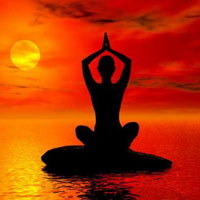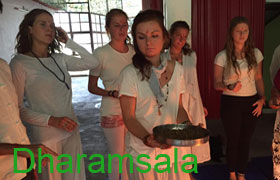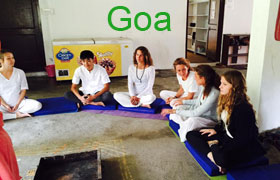Jnana Yoga
Jnana yoga is one of the four principle ways of yoga and the most immediate way to achieve the objective depicted in the theory of advaita Vedanta: Self-acknowledgment.
This is the most challenging way, obliging enormous quality of will and mind. Taking the reasoning of Vedanta the Jnana Yogi utilizes his brain to ask into its own particular nature. We discern the space inside and outside a glass as distinctive, similarly as we see ourselves as differentiate from God. Jnana Yoga heads the enthusiast to encounter his solidarity with God straightforwardly by breaking the glass, dissolving the cloak of lack of awareness. When rehearsing Jnana Yoga, the applicant requirements to have joined the lessons of the other yogic ways – for without benevolence and adoration of God, quality of form and brain, the quest for self-acknowledgment can get to be negligible unmoving theory.
Jnana yoga is the yoga of information not learning in the intelligent sense—however the learning of Brahman and Atman and the acknowledgment of their solidarity. Where the lover of God takes after the promptings of the heart, the jnani utilizes the forces of the brain to segregate between the true and the stunning, the changeless and the momentary.
Jnanis, supporters of no dualistic or advaita Vedanta, can additionally be called monists for they avow the sole actuality of Brahman. Obviously, all devotees of Vedanta are monists: all Vedantins certify the sole actuality of Brahman. The qualification here is in profound practice: while all Vedantins are thoughtfully monistic, in practice the individuals who are enthusiasts of God like to consider God unique from them keeping in mind the end goal to appreciate the sweetness of a relationship. Jnanis, by complexity, realize that all duality is lack of awareness. There is no compelling reason to search outside ourselves for holiness: we ourselves recently are celestial.
Jnana implies the information. This yoga is the yoga for the smart and chose individuals. This yoga is a definitive objective of the various mixed bags of yoga. This yoga shows you to take a gander at the planet as it is without any lack of awareness and predisposition. You can attain this state by polishing thorough mental order and prudence. This yoga is likewise called Raja Yoga or the ruler of every last one of yoga’s, since it is of the most astounding assortment and leads over the various assortments. This is the Yoga that Patanjali has portrayed in his Yoga Sutras.
This yoga is made up of eight parts of which five are outside and the other three are interior. Two of its parts, via yama and niyama bargain with sorts of conduct that the scholar of yoga might as well stay away from like lying, conning, taking and so on and those behaviors that he might as well grow like cleanliness, non-accumulation and so on. Asanas and Pranayama are the following two parts of this yoga. Asanas are the physical developments that help in improving the suppleness of the form and hence cure any maladies. You can control your breath by utilizing pranayama which builds the limit of the lungs to take in air and in this manner expands the essentialness of the form. The following part Pratyahara signifies the withdrawal of the sense organs from objects of delight. The remaining three parts bargain with extreme mental fixation.
Patanjali administered that polishing these eight parts of yoga dependably and strongly will, over a time of time, eradicate all the pollutions of the form and brain and therefore achieve learning that will free the individual from subjugation and obliviousness. This yoga is called Ashtanga Yoga since it is made of eight parts. It is likewise called as Dhyana yoga because of its push on mental focus. Henceforth, at whatever point there is any notice of yoga, it is normally inferred that the individual is discussing Jnana Yoga.
The profits of Jnana Yoga are complex. The individual, who takes after this comprehensive way of Jnana Yoga, achieves serenity, which is the craft of remaining quiet even despite affliction. Discretion in one’s self is accomplished by taking after Jnana Yoga. An alternate profit of emulating this all-encompassing way is suspension, or keeping one’s self swore from the movements that are insignificant to the support of the form and the hunt for inward illumination. After a critical period, the individual even accomplishes persistence. He/she is remains unruffled by the play of the contrary energies in Nature, for example, hotness and chilly, delight and agony, acclaim and rebuff. Separated from this, the individual remains resolute in all the circumstances. He/she likewise gets fit to expand his/her fixation power.








